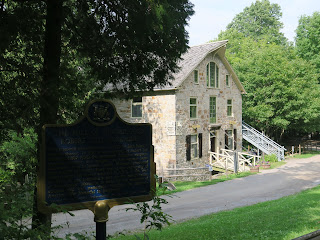And a sculptor emerged?
R.Tait McKenzie's story conjures a Wilfred Owen world of British public school boys on frozen playing fields, hardening themselves for future leadership roles on WWI battlefields, challenging themselves and others to greatness. A Canadian version.
Lest this playing fields of Eton analogy feel like too much of a stretch, McKenzie's boyhood friend was another heralded local boy, James Naismith, inventor of basketball.
 I visited McKenzie's Lanark County studio-home this past summer. No, he wasn't there to greet me, but I spent time in his presence on the magnificent second floor of the restored mill. Here is a well-curated and evocative display of over 70 of his works - originals and plaster models of commissioned works which are on display throughout the world.
I visited McKenzie's Lanark County studio-home this past summer. No, he wasn't there to greet me, but I spent time in his presence on the magnificent second floor of the restored mill. Here is a well-curated and evocative display of over 70 of his works - originals and plaster models of commissioned works which are on display throughout the world. |
| bas reliefs recalling Wyle and Loring |
But I digress (not for the first time. )
 |
| Fugit Umbra, Caritas Manet, Carpe Diem, Maneo Nemini |
McKenzie purchased the 50 acre site, rebuilt the mill and even the ruined dam, washed away by spring ice long before. The millpond provided a swimming pool, the site of legendary summer entertainments orchestrated by his musician/poet wife Ethel O'Neil. They named the place Mill of Kintail. Kintail is Scottish Gaelic for a spot in the Scottish Highlands.
The Arts and Crafts feel of the fireplace nook, and wonderful touches throughout the main floor of the mill home, are worth the price of admission. Oh wait, there is none. The Naismith basketball museum, I left for another day.
The sandstone mill was built in 1830 by Scottish pioneer John Baird, along the Indian River, tributary of the Mississippi River (the one that flows into the Saint Lawrence.) There is a bridge over the trickle, which leads one directly into the forest (where a bear warning was posted the day of my visit.) The view at top taken from the opposite bank was just about as far as I travelled into the wilds of Lanark County.
The Mississippi Valley Conservation Authority also did a fine thing, when they created the Mill of Kintail Conservation Area. The miller's fine stone house, in ruins when Mackenzie first saw the property in 1931, near the road is now a meeting area, the mill a museum to two native sons, Mackenzie and Naismith, and the 150+ acres bordering the river and wandering the woods is a natural recreation space - Mackenzie would have been pleased.
* The Canadian Encyclopedia







Wonderful find, really beautiful! Allanah
ReplyDelete